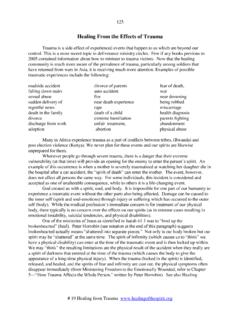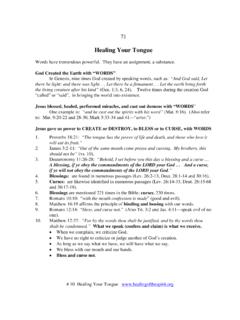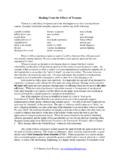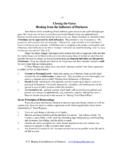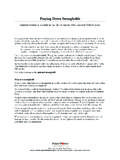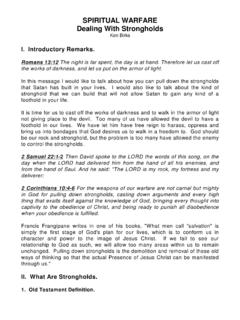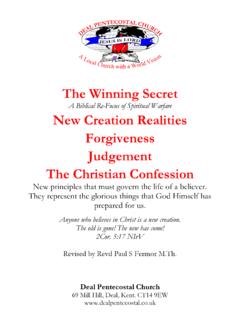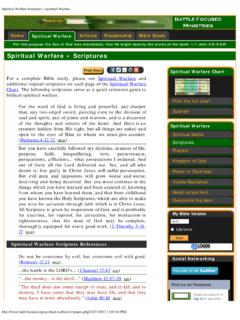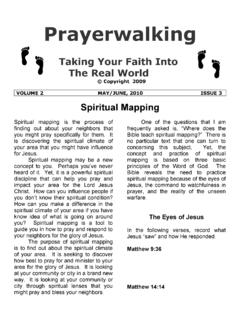Transcription of Healing from Territorial Spirits - Healing of the …
1 158 # 27 Setting Your Church Free Healing from Territorial Spirits This chapter will address (1) setting your church free, (2) setting your neighborhood or city free, and (3) transformation revival that can take place after churches and towns are set free. Evangelism roadblocks. Most congregations have as part of their mission the goal of evangelism, of ful-filling the great commission (Mat. 28:19, Mark 16:15). In addition, most congregations have been less than successful in this effort. In the late 1960 s Derek Prince, C. Peter Wagner, Gwen Shaw and others began to notice that in some churches, evangelism flourished, while in others it was extremely diffi-cult or not at all. They began to recognize the existence of principalities and powers over churches, towns, regions and countries. In the late 1980 s and early 1990 s writers began to document the commonalities of such examples.
2 They found that a common denominator was what C. Peter Wagner calls Strategic warfare Prayer, the 3rd level of praying against dark-ness. As early as 1976, evangelist and internationally known minister, Derek Prince, re-ported, For several years I have believed that over every major city in the nation, Satan has set a strong man an unseen spiritual power responsible for resisting God s purposes and God s people in that particular area (Fall, 1976 newsletter). Consider the following true illustrations: 1. In Adrogue, Brazil, a Baptist Church had only 70 members after 70 years of evangelism effort; it was a graveyard of church planters. Also, none of the 70 members were resi-dents of Adrogue. Then, in 1974, Eduardo Lorenzo became pastor. By 1987 there were 250 members; by 1990 there were 600; by 1991, 1000; by 1993, 2000.
3 When asked what happened in 1987, Pastor Lorenzo simply replied that he began using spiritual warfare prayer. 2. Pastor Albarto's Los Olivus Baptist Church in Argentina had for many years been stalled at 50 members. After attending an Annacondia crusade, Pastor Alberto and his lay lead-ers held a crusade themselves. After the first service, he gave the invitation to come for-ward. No one responded. While inwardly agonizing over the apparent lack of power and response, he seemed to hear an inner voice say to him, "Try it the way Annacondia does it." In semi-desperation, he decided to try it. He prayed a strong warfare prayer and di-rectly rebuked the Spirits , as he had previously seen Carlos Annacondia do. When he had bound the Spirits with the authority Jesus Christ had given him, he gave the invitation to come forward once again.
4 This time, more than 15 people sprang out of their seats and actually came running to the front of the church to receive Christ as their Savior. In the 159 # 27 Setting Your Church Free next short while, the church grew to 900 members and started satellite congregations of 2,100 members. His goal is 20,000 members. 3. Pastor Steve Nicholson preached the gospel in Evanston, Illinois, for six years with vir-tually no fruit. He and members of his church prayed for the sick and few got well. His Vineyard Christian Fellowship was not growing. Nicholson began some serious prayer and fasting. A grotesque, unnatural being appeared to him. It growled, Why are you bothering me? It identified itself as a demon of witchcraft which had dominion over the geographical area. In the heat of warfare , Nicholson named the city streets in the sur-rounding area.
5 The spirit retorted, I don t want to give you that much. In the name of Jesus, Nicholson commanded the sprit to give up the territory. During the next three months, the church doubled in size form 70 to 150, mostly from new converts coming out of witchcraft. Nearly all of the new believers needed to be delivered from demons. Three observations can be made from the above examples (as well as from many oth-ers not here included): All the evangelistic technology and effort in the world will have only minimal effect unless the spiritual battle is won first. We need to focus on the spiritual dimension of church growth, not on programs and techniques. Many people who have not received Christ as their Lord and Savior have not done so because they cannot because Satan has blinded them and holds them captive (2 Cor.)
6 4:4). In each of the above examples, the reason for these meager evangelism results was determined to be spiritual rather than physical: For we wrestle not against flesh and blood, but against principalities, against powers, against the rulers of the darkness of this world, against spiritual wickedness in high places (Eph 6:12). Even so, .. the weapons of our warfare are not carnal, but mighty through God to the pulling down of strongholds (2 Cor. 10:4). From these examples, a most fundamental observation is that these successful churches have a more advanced understanding that the real battle for evangelism is spiritual . Signs and wonders, deliverance from demonic powers, miraculous healings, sustained and enthusiastic worship, prophecies, and warfare prayer are seen by many of these ministries as the normal outworking of Christianity.
7 Unless biblical warfare is understood, there will continue to be frustration, anger, confusion, and ineffective ministry within the congregations ignorant of spiritual warfare prayer. Whether attempting to coordinate Christian concerts, plant a church, or perform out-reach, the principle is still the same: we need to bind the strongman and gain a place of authority over Satan before we will see the full fruit of our labors. Evangelism and other church programs will not thrive until the influence of darkness over the people, church, and sometimes the town is removed. Churches must win the war against strongholds in the church first, before they will be effective in evangelism Setting churches free from the influences of darkness that restrains them requires two primary beliefs: (1) a belief that the Spirits of darkness inhabit people and places (ground 160 # 27 Setting Your Church Free level spiritual warfare ) and (2) the sins of people cause a curse on the land, giving certain Spirits of darkness a spiritual legal right to inhabit the place or land, until they are expelled ( Territorial or strategic level spiritual warfare ).
8 Territorial Spirits Anyone who has paid more than a casual visit to places such as India, Navajoland, Cameroon, Haiti, Japan, Morocco, Peru, Nepal, New Guinea, and China will attest to seeing elaborate hierarchies of deities and Spirits , regarded as commonplace in these locations. The-se incorporeal beings are perceived to rule over homes, villages, cities, valleys, providences, and nations, and they exercise extraordinary power over the behavior of local people. Jacob Loewen, an anthropologist and a Bible translation consultant, sees the Old Tes-tament as clearly assuming the territoriality ( Territorial status) of demonic Spirits , frequently called "deities." He reports that in Central and South America, Spirits are considered to be the "owners" of geographical or topographical phenomena. Nomadic Indians never travel from one territory to another without first securing the permission of the Territorial spirit dominating the area that they are about to enter.
9 Vernon Sterk, a field missionary in Mexico for over 20 years for the Reformed Church of America, says that every one of the Tzotzil tribes can identify specific deities by name. He discovered that both evil Spirits and guardian Spirits have Territorial designations and assignments. All of the Spirits have geographical limits for their power, even though the reach of the evil Spirits seems to be more extensive than that of the guardian or ancestral spir-its. The above information raises several questions. (1) Is the existence of Territorial Spirits scriptural? (2) If principalities and powers in the form of Territorial Spirits have such a negative effect on the work of churches, how does this happen? (3) How can they be identified? (4) How can they be expelled or removed? Is the existence of Territorial Spirits scriptural?
10 Consider the following: 1. Satan is the ruler of this world (John 12:31, 14:30, 16:11, 2 Cor. 4:4). 2. Christ, when tempted by Satan, did not dispute Satan s power to give him all the kingdoms of the world and the glory of them (Mat. 4:8-9). 3. Satan delegates his power to principalities, powers, and rulers of darkness (Eph. 6:12). There may be millions of dark Spirits of various kinds. Mark 5:9 suggests the name of the spirit was Legion, which is up to 6,000. 4. While some evil Spirits (or demons) inhabit persons, others called guardian or ances-tral Spirits inhabit geographical locations or areas. 5. Other scriptures speaking of the hierarchy of Satan include the following: Deut. 12:2-3 and 32:17 1 Ki. 20:23 1 Cor. 15:32 Judg. 3:7 2 Ki. 17:16, 29-31 Rev. 12:6-10 1 Sam. 7:3-4 Dan. 10:13 Rev.


